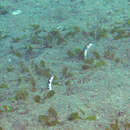en
names in breadcrumbs


The zebra garden eel (Heteroconger polyzona), also known as the banded garden eel,[2] is a species of eel in the conger/garden eels family Congridae.[3] It was described by Pieter Bleeker in 1868.[4] It is a marine, tropical eel which is known from the Indo-Western Pacific, including the Philippines, the Ryukyu Islands, New Guinea, Indonesia and Vanuatu. It inhabits shallow waters at a depth range of 1 to 10 m (3.3 to 32.8 ft), and forms burrows in colonies of moderate size on sand sediments in bays, slopes and reefs. Males can reach a maximum total length of 34.7 cm (13.7 in; 1.14 ft).[3]
The zebra garden eel (Heteroconger polyzona), also known as the banded garden eel, is a species of eel in the conger/garden eels family Congridae. It was described by Pieter Bleeker in 1868. It is a marine, tropical eel which is known from the Indo-Western Pacific, including the Philippines, the Ryukyu Islands, New Guinea, Indonesia and Vanuatu. It inhabits shallow waters at a depth range of 1 to 10 m (3.3 to 32.8 ft), and forms burrows in colonies of moderate size on sand sediments in bays, slopes and reefs. Males can reach a maximum total length of 34.7 cm (13.7 in; 1.14 ft).